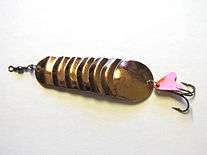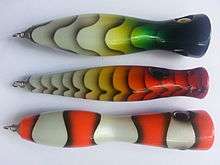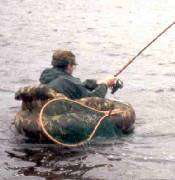Fishing lure





A fishing lure is a type of artificial fishing bait which is designed to attract a fish's attention. The lure uses movement, vibration, flash and color to bait fish. Many lures are equipped with one or more hooks that are used to catch fish when they strike the lure. Some lures are placed to attract fish so a spear can be impaled into the fish or so the fish can be captured by hand. Most lures are attached to the end of a fishing line and have various styles of hooks attached to the body and are designed to elicit a strike resulting in a hookset. Many lures are commercially made but some are hand made such as fishing flies. Hand tying fly lures to match the hatch is considered a challenge by many amateur entomologists.
Modern commercial lures usually are often used with a fishing rod and fishing reel but there are some who use a technique where they hold the line in their hands. Handlining is a technique in which the line is held directly in the hands versus being fed through the guides of a fishing rod. Longlining also can employ lures to catch fish. When a lure is used for casting, it is continually cast out and retrieved, the retrieve making the lure swim or produce a popping action. A skilled angler can explore many possible hiding places for fish through lure casting such as under logs and on flats.
History
In early time, fishing lures were made from bone or bronze. The Chinese and Egyptians used fishing rods, hooks, and lines as early as 2,000 B.C., though most of the first fishermen used handlines. The first hooks were made out of bronze, which was strong but still very thin and less visible to the fish. The Chinese were the first to make fishing line, spun from fine silk. The modern fishing lure was made commercially in the United States in the early 1900s by the firm of Heddon and Pflueger in Michigan. Before this time most fishing lures were made by individual craftsman. Commercial-made lures were based on the same ideas that the individual craftsmen were making but on a larger scale.[1]
Methods
The fishing lure is either tied with a knot, such as the improved clinch knot, or connected with a tiny safety pin-like device called a "swivel" onto the fishing line which is in turn connected to the reel via the arbor. The reel is attached to a rod. The motion of the lure is made by winding line back on to the reel, by sweeping the fishing rod, jigging movements with the fishing rod, or by being pulled behind a moving boat (trolling). exceptions included are artificial flies, commonly called flies by fly fishers, which either float on the water surface, slowly sink or float underwater, and represent some form of insect fish food.
Types
There are many types of fishing lures. In most cases they are manufactured to resemble prey for the fish, but they are sometimes engineered to appeal to a fishes' sense of territory, curiosity or aggression. Most lures are made to look like dying, injured, or fast moving fish. They include the following types:
- A jig is a weighted hook with a lead head opposite the sharp tip. They usually have a minnow or crawfish or even a plastic worm on it to get the fish's attention. Deep water jigs used in saltwater fishing consist of a large metallic weight, which gives the impression of the body of the bait fish, which has a hook attached via a short length of kevlar usually to the top of the jig. Some jigs can be fished in water depths down to 300 metres.
- Surface lures are also known as top water lures, poppers and stickbaits. They float and look like fish prey that is on top of the water. They can make a popping, burbling, or even a buzzing sound. It takes a long time to learn how to use this lure effectively
- Spoon lures usually look like a spoon, with a wide rounded end and a narrower pointed end, similar n shape to a concave spearhead. They flash in the light while wobbling and darting due to their shape, which attracts fish.
- LED lures have a built in led and battery to attract fish. They use a flashing or sometimes strobing pattern, using a combination of colors and leds.[2]
- Plugs are also known as crankbaits or minnows. These lures look like fish and they are run through the water where they can move in different ways because of instability due to the bib at the front under the head.
- Artificial flies are designed to resemble all manner of fish prey and are used with a fly rod and reel in fly fishing.[3]
- Soft plastic baits are lures made of plastic or rubber designed to look like fish, crabs, squid, worms, lizards, frogs, leeches and other creatures.
- Spinnerbait are pieces of wire that are bent at about a 60 degree angle with a hook at the bottom and a flashy spinner at the top.
- Swimbait is a soft plastic bait/lure that resembles an actual bait fish. Some of these have a tail that makes the lure/bait look like it is swimming when drawn through the water.
- Fish decoy is a type of lure that traditionally was carved to resemble a fish, frog, small rodent, or an insect that lures in fish so they can be speared. They are often used through the ice by fishermen and also by the Inuit people as part of their diet. The Mitchell Museum of the American Indian collection includes Native American fish decoys. William Jesse Ramey is considered a vintage master carver of fish decoys, and his work has been featured in museums.[4]
Fishing lures can be made of wood, plastic, rubber, metal, cork, and materials like feathers, animal hair, string, tinsel and others. They can have many moving parts or no moving parts. They can be retrieved fast or slow. Some of the lures can be used by alone, or with another lure.
One advantage of use of artificial lures is a reduction in use of bait. This contributes to resolving one of the marine environment's more pressing problems; the undermining of marine food webs by overharvesting "bait" species which tend to occur lower in the food chain.[5] Another advantage of lures is that their use promotes improved survival of fish during catch and release fishing. This is because lures reduce the incidence of deep hooking which has been correlated to fish mortality in many studies.
Daisy chain
A daisy chain is a teaser consisting of a "chain" of plastic lures run without hooks. The daisy chain mimics a possible school of baitfish, food for a larger predator. The purpose of a daisy chain is to attract pelagic fish to the stern of a boat into the lure "spread", which consists of a number of lures rigged with hooks.
Typically, the main line of the daisy chain is clear monofilament line with crimped on droppers that connect the lure to the main line. The last lure can be rigged with a hook or unrigged. The unrigged versions are used as teasers while the hooked versions are connected to a rod and reel. The lures used on a daisy chain are made from cedar plugs, plastic squids, jets, and other soft and/or hard plastic lures.
In some countries (e.g. New Zealand) daisy chains can sometimes refer to a rig which is used to catch baitfish in a similar arrangement to a 'flasher rig' or a 'sabiki rig'; a series of hooks with a small piece of colourful material/feather/plastic attached to each hook.
See also
References
| Wikimedia Commons has media related to Fishing lure. |
- ↑ "History of the fishing lure". Madehow.com. Retrieved 2013-06-16.
- ↑ Light, Dynamite. "Dynamite Light The LED Lure". dl-lure.com. Retrieved 2016-03-30.
- ↑ Types of Fly Fishing Flies
- ↑ American Fish Decoys by Steven Michaan
- ↑ Daniel Pauly; et al. "Fishing Down Marine Food Webs". Seafriends.org.nz. Retrieved 2012-02-24.

